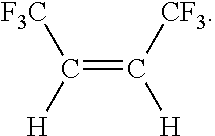Process for cis 1,1,1,4,4,4-hexafluoro-2-butene
- Summary
- Abstract
- Description
- Claims
- Application Information
AI Technical Summary
Benefits of technology
Problems solved by technology
Method used
Image
Examples
example 1
Addition of CCL4 to CF3CCl═CHCl
In to a 1 Liter clean, dry stainless steel Parr Reactor was added CCl4 (154 g, 1.0 mol), followed by CuCl2 (1.35 g, 0.01 mol) and acetonitrile (50 mL). The reactor was closed, cooled to −20° C. and CF3CCl═CHCl (124 g, 0.75 mol) was introduced as a liquid at about 0° C. The content in the reactor was heated to maintain a temperature of from 130° C. to 140° C. for 16 hours. After cooling to room temperature (about 20° C.), more volatile materials were evaporated and the residue was washed with 1M HCl (50 mL) and water (2×100 mL) and dried (MgSO4). The product was distilled to afford 185 g (77%) CF3CCl2CHClCCl3.
In a similar manner, the reaction was conducted as above except that CF3CCl═CFH was used as the starting material instead of CF3CCl═CHCl to afford CF3CCl2CFHCCl3 in 80% yield.
example 2
Fluorination of CF3CCL2CHCCC3
To a 1 Liter autoclave / Parr reactor was charged SbCl5 (25 g) and CF3CCl2CHClCCl3 (200 g, 0.63 mol) under a nitrogen atmosphere. The reactor was cooled to 0° C. and anhydrous HF (120 g) was condensed and added to the reactor. The contents of the autoclave were heated to and maintained at a temperature of from 90° C. to 100° C. with agitation for 1 hour. As the reaction proceeded an increase in pressure was observed. The reactor was cooled to about 20° C. and vented to cold traps. The product in the autoclave was washed with water and caustic solution to afford CF3CCl2CHClLCF3 (119 g, 70% yield).
The above reaction was conducted in the same manner except that CF3CCl2CFHCCl3 was used instead of CF3CCl2CHClCCl3 as the starting material to afford 75% yield of CF3CHClCFHCF3.
Vapor phase fluorination of CF3CCl2CHClCCl3 with Cr2O3 / Al2O3 catalyst was conducted in a similar manner as described in Examples 3-6 of WO 9711043 A1. A 60% to 80% conversion of CF3CCl2CHCl...
example 3
Dehydrohalogenation of CF3CCl2CHClCF3
To a 500 ml aqueous solution of KOH (20 wt %) containing a phase transfer catalyst (Aliquat 336, 1.5 mmol) at about 0° C. in an autoclave was added CF3CCl2CHClCF3 (0.2 mol) and stirred for 2 hours. Analysis of the volatile material by gas chromatography indicated the main product as CF3CCl≡CClCF3. Further purification was achieved by distillation
PUM
 Login to View More
Login to View More Abstract
Description
Claims
Application Information
 Login to View More
Login to View More - R&D
- Intellectual Property
- Life Sciences
- Materials
- Tech Scout
- Unparalleled Data Quality
- Higher Quality Content
- 60% Fewer Hallucinations
Browse by: Latest US Patents, China's latest patents, Technical Efficacy Thesaurus, Application Domain, Technology Topic, Popular Technical Reports.
© 2025 PatSnap. All rights reserved.Legal|Privacy policy|Modern Slavery Act Transparency Statement|Sitemap|About US| Contact US: help@patsnap.com



